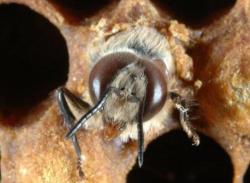Bees pollinate 70 out of the leading 100 human food crops. Worldwide, 80% pollination is done by the humble tiny honeybee. In spite of knowing about the dominance of bees in the world agricultural web, scientists have been pushed to spot a single cause of their fast and concerning fall.
Swiss researchers recently conducted a study that could be helpful in exposing the causes of the fall in the world honeybee populations. For long, they suspected that pesticides, mainly neonicotinoids, could play a part, but now researchers said that neonicotinoids may be at the root of the issue, decreasing the count of bee sperms and restricting reproduction.
In a press release, lead author Lars Straub of the University of Bern said, “Most neonicotinoid studies that employ honey bees have focused on workers, which are typically the non-reproductive females of the colony. Male honey bees have really been neglected by honey bee health scientists. While not surprising, these results may turn a few heads”.
Previously in January, a research noted that honeybee populations had declined 25% in Europe since 1996, and 59% in the past 58 years in North America. A countrywide survey was carried out between April last year and April 2016 in the United States which discovered that beekeepers lost 44% of their colonies in the twelve-month time period.
It has indicated numerous factors, ranging from climate change to parasite issues to the decrease in biodiversity in the plants on which bees step on for pollen, may be responsible.
Lately, researchers also came to know that issues with colonies’ mothers, the prominent queen bees of pollinator colonies, also play a part in the decline.
In an interview, the US Department of Agriculture bee scientist Jeff Pettis, involved in the latest research on bee sperm counts, said that queen failure is a huge issue.
A report published in UPI revealed, “The litany of negative health effects pesticides cause honey bees continues to grow. Add sexual potency to the list. New research suggests two neonicotinoid insecticides diminish the lifespans and sperm counts of male drones, thus limiting the productivity of queen bees.”
A number of studies have shown the ability worker honey bees to find nectar and fight disease are diminished by insecticides. The latest study — detailed in the journal Proceedings of the Royal Society B — focuses not on workers, but drones, and shows the negative health effects of some insecticides are more pervasive than previously thought.
“Most neonicotinoid studies that employ honey bees have focused on workers, which are typically the non-reproductive females of the colony,” lead study author Lars Straub, a doctoral student at the University of Bern, said in a news release. “Male honey bees have really been neglected by honey bee health scientists; while not surprising, these results may turn a few heads.”
According to a report in CS Monitor by Christina Beck, “A recent study by Swiss researchers may help demystify the causes of the decline in world honeybee populations. Scientists have long suspected that pesticides, specifically neonicotinoids, may play a role. Now, researchers say that neonicotinoids could be at the root of the problem, reducing bee sperm count and limiting reproduction.”
“Most neonicotinoid studies that employ honey bees have focused on workers, which are typically the non-reproductive females of the colony,” said lead author Lars Straub of the University of Bern in a press release. “Male honey bees have really been neglected by honey bee health scientists.”
“Queen failure is a big problem and this helps explain it,” said US Department of Agriculture bee scientist Jeff Pettis of the recent research on bee sperm counts, in an interview with the Associated Press. Dr. Pettis took part in the queen study earlier this year. “It’s not the queens themselves, it’s the drones. It’s significant.”
[Source:-Northen Califrnia news]




